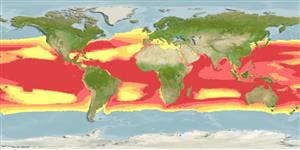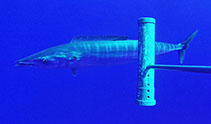Acanthocybium solandri (Cuvier, 1832)
Wahoo
Добавить Ваши наблюдения в Fish Watcher
| Native range | All suitable habitat | Point map | Year 2050 |

|
| This map was computer-generated and has not yet been reviewed. |
| Acanthocybium solandri AquaMaps Data sources: GBIF OBIS |
Загрузить свой Фото и Видео
Pictures | Videos | Stamps, coins, misc. | Изображение на GoogleAcanthocybium solandri
Picture by University of Western Australia (UWA)
Pictures | Videos | Stamps, coins, misc. | Изображение на GoogleAcanthocybium solandri
Picture by University of Western Australia (UWA)
India country information
Common names:
Ayakkura, Digu-mas, Oria Neemeen
Occurrence: native
Salinity: marine
Abundance: | Ref:
Importance: | Ref:
Aquaculture: | Ref:
Regulations: | Ref:
Uses: no uses
Comments:
National Checklist:
Country Information: https://www.cia.gov/library/publications/resources/the-world-factbook/geos/in.html
National Fisheries Authority:
Occurrences: Occurrences Point map
Main Ref: Collette, B.B. and C.E. Nauen, 1983
National Database:
Occurrence: native
Salinity: marine
Abundance: | Ref:
Importance: | Ref:
Aquaculture: | Ref:
Regulations: | Ref:
Uses: no uses
Comments:
National Checklist:
Country Information: https://www.cia.gov/library/publications/resources/the-world-factbook/geos/in.html
National Fisheries Authority:
Occurrences: Occurrences Point map
Main Ref: Collette, B.B. and C.E. Nauen, 1983
National Database:
Common names from other countries
Классификация / Names народные названия | синонимы | Catalog of Fishes(род, виды) | ITIS | CoL | WoRMS | Cloffa
> Scombriformes (Mackerels) > Scombridae (Mackerels, tunas, bonitos) > Scombrinae
Etymology: Acanthocybium: Greek, akantha = thorn + Greek, kybion. -ou = a tunna (Ref. 45335).
Eponymy: Daniel Carl [Karl] Solander (1733–1782) was a Swedish naturalist and explorer who was one of Linnaeus’s pupils at Uppsala. [...] (Ref. 128868), visit book page.
More on author: Cuvier.
Etymology: Acanthocybium: Greek, akantha = thorn + Greek, kybion. -ou = a tunna (Ref. 45335).
Eponymy: Daniel Carl [Karl] Solander (1733–1782) was a Swedish naturalist and explorer who was one of Linnaeus’s pupils at Uppsala. [...] (Ref. 128868), visit book page.
More on author: Cuvier.
Environment: milieu / climate zone / depth range / distribution range экология
морской; мигрирует в океане (Ref. 51243); пределы глубины 0 - 20 m (Ref. 89972), usually 0 - 12 m (Ref. 5227). Subtropical; 59°N - 48°S, 180°W - 180°E
распространение страны | регионы FAO | Ecosystems | места находок | Point map | интродукции | Faunafri
Atlantic, Indian and Pacific Oceans: in tropical and subtropical waters, including the Caribbean and Mediterranean seas.
Length at first maturity / Size / Вес / Возраст
Maturity: Lm 99.3, range 85 - 105 cm
Max length : 250 cm TL самец/пол неопределен; (Ref. 30573); common length : 170 cm FL самец/пол неопределен; (Ref. 9340); наибольший вес (опубликованные данные): 83.0 kg (Ref. 168)
Max length : 250 cm TL самец/пол неопределен; (Ref. 30573); common length : 170 cm FL самец/пол неопределен; (Ref. 9340); наибольший вес (опубликованные данные): 83.0 kg (Ref. 168)
Краткое описание определительные ключи | морфология | морфометрия
колючие лучи спинного плавника (общее число) : 23 - 27; членистые (мягкие) лучи спинного плавника (общее число) : 12 - 16; колючие лучи анального плавника: 0; членистые (мягкие) лучи анального плавника: 12 - 14; позвонки: 62 - 64. Mouth large with strong, triangular, compressed and finely serrate teeth. Snout about as long as the rest of head. Posterior part of maxilla completely concealed under preorbital bone. Gill rakers absent. Interpelvic process small and bifid. Swim bladder present. Body covered with small scales. No anterior corselet developed. The back is iridescent bluish green; the sides silvery with 24 to 30 cobalt blue vertical bars which extend to below the lateral line.
An oceanic, epipelagic species frequently solitary or forming small loose aggregations rather than compact schools. Feed on fishes and squids. Eggs and larvae are pelagic (Ref. 6769). An important sport fish in some areas (Ref. 9340). Marketed fresh, salted or spice-cured slices of meat; also frozen (Ref. 9987). Flesh of very good quality (Ref. 9684). Minimum depth from Ref. 005227.
Life cycle and mating behavior половая зрелость | размножение | нерест | икра | Fecundity | личинки
Spawning seems to extend over a long period; fish in different maturity stages are frequently caught at the same time.
Основная ссылка
Upload your references | ссылки | координатор : Collette, Bruce B. | соавторы
Collette, B.B. and C.E. Nauen, 1983. FAO Species Catalogue. Vol. 2. Scombrids of the world. An annotated and illustrated catalogue of tunas, mackerels, bonitos and related species known to date. Rome: FAO. FAO Fish. Synop. 125(2):137 p. (Ref. 168)
Статус Красного Списка МСОП (Ref. 130435: Version 2024-2)
Не вызывающий беспокойства (LC) ; Date assessed: 01 March 2022
Использование человеком
рыболовство: коммерческий; объект спортивного рыболовства: да
FAO(рыболовство: production; publication : search) | FIRMS (Stock assessments) | FishSource | Sea Around Us
дополнительная информация
Population dynamics
Growth parameters
Max. ages / sizes
Length-weight rel.
Length-length rel.
Размерный состав
Mass conversion
пополнение
численность
Growth parameters
Max. ages / sizes
Length-weight rel.
Length-length rel.
Размерный состав
Mass conversion
пополнение
численность
Life cycle
размножение
половая зрелость
Fecundity
нерест
Spawning aggregations
икра
Развитие икры
личинки
динамика численности личинок
размножение
половая зрелость
Fecundity
нерест
Spawning aggregations
икра
Развитие икры
личинки
динамика численности личинок
Physiology
Body composition
Nutrients
Oxygen consumption
Swimming type
Swimming speed
Visual pigments
Fish sound
Diseases & Parasites
Toxicity (LC50s)
Body composition
Nutrients
Oxygen consumption
Swimming type
Swimming speed
Visual pigments
Fish sound
Diseases & Parasites
Toxicity (LC50s)
Genetics
генетика
Heterozygosity
наследуемость
генетика
Heterozygosity
наследуемость
Human related
Aquaculture systems
особенности рыбоводства
степень растяжения
Ciguatera cases
Stamps, coins, misc.
Aquaculture systems
особенности рыбоводства
степень растяжения
Ciguatera cases
Stamps, coins, misc.
инструменты
E-book | полевой определитель | определительные ключи | Длина-Частота | онтогенез | карта точек | Classification Tree
| Catch-MSY |
Специальные отчеты
Проверить содержание в аквариумах | Проверить опубликованные видовые данные | Проверить опубликованные данные по аквакультуре
Скачать в формате XML
ресурсы в Интернет
Aquatic Commons | BHL | Cloffa | BOLDSystems | Websites from users | Проверить FishWatcher | CISTI | Catalog of Fishes(род, виды) | DiscoverLife | ECOTOX | Faunafri | Fishtrace | GenBank(Геном, Нуклеотид) | GloBI | GOBASE | | Google Books | Google Scholar | Google | IGFA World Record | MitoFish | национальные базы данных | Otolith Atlas of Taiwan Fishes | PubMed | Reef Life Survey | Scirus | SeaLifeBase | Tree of Life | Wikipedia(Вперёд, поиск) | World Records Freshwater Fishing | Zoological Record
Estimates based on models
Preferred temperature (Ref. 115969): 18.2 - 27.6, mean 24.7 (based on 46871 cells).
Phylogenetic diversity index (Ref. 82804): PD50 = 1.0000 [Uniqueness, from 0.5 = low to 2.0 = high].
Bayesian length-weight: a=0.00275 (0.00197 - 0.00385), b=3.17 (3.07 - 3.27), in cm Total Length, based on LWR estimates for this species (Ref. 93245).
Trophic level (Ref. 69278): 4.3 ±0.2 se; based on diet studies.
устойчивость к внешним воздействиям (Ref. 120179): средний (среднего размера), минимальное время удвоения популяции 1.4-4.4 года (K=0.34; tm=1-2 y; tmax >4; Fec=6 million).
Prior r = 0.84, 95% CL = 0.55 - 1.26, Based on 1 full stock assessment.
Fishing Vulnerability (Ref. 59153): Moderate to high vulnerability (46 of 100).
Climate Vulnerability (Ref. 125649): Very high vulnerability (76 of 100).




